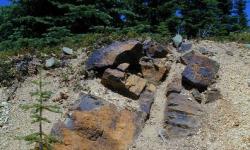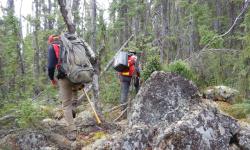Eagle Plains Commences Drill Program on Sphinx Molybdenum Project, South-eastern B.C., Canada
British Columbia | May 9, 2005Bulk-Mineable Molybdenum Resource Targeted
Cranbrook, B.C. 09 May, 2005: Eagle Plains Resources Ltd. (EPL: TSX-V) has commenced a 10-hole, 2000m diamond drilling program on its 100% controlled Sphinx property, located 60 km west of Kimberley, BC. The claims consist of a total area of 2500 ha, with 1600 ha acquired by staking by EPL and 900 ha subject to an option to earn 100% interest (less 1% NSR) from arms-length individuals.
Infrastructure
The claims are ideally located with respect to local infrastructure. The property is road-accessible, has been logged extensively and is situated along a high-voltage hydro-electric line. Rail facilities are located 60km east of the property.
History
The project area was first identified by Cominco Ltd. in 1978, which carried out surface work and limited diamond drilling from 1978 to 1984. Cominco completed a soil geochemical survey which resulted in the delineation of a 1700m x 500m tungsten-moly anomaly. 4-6 drill holes were completed, but no results were released. In 1997, Barkhor Resources drilled 10 holes into the soil anomaly and encountered significant mineralization over a 1000m x 300m area. Results from only one hole were ever released (DDH JI97-06), but a private consultant reported that “typical drill intersections are averaging 0.03-0.038% Mo over core lengths ranging from 90 to 230m”. At the time of the Barkhor drill program, molybdenum sold for $ 5.00 US per pound, with the metal currently priced at $34.00 US per pound.
Geology
The property overlies sedimentary units that have been intruded by intrusive rocks. Molybdenum and associated tungsten mineralization occurs as quartz-pyrite stockwork veins hosted by both sedimentary and intrusive rocks. Chemical alteration of rock units suggests the presence of a substantial porphyrystyle mineralizing system.
Current Program
EPL has consolidated a large land package which includes all significant claims in the area, including lands suitable for mine infrastructure and tailings areas. In 2004, EPL completed an airborne geophysical survey that outlines a large intrusive feature associated with the previously-defined soil anomaly. All core from the 1997 program has been secured and examined - available assay results have been compiled and interpreted.
From these assay results, the following intervals have been determined:
JI97-006: 18.3m to 45.2m (26.9m) @ 0.072 % Mo
inc. 28.8m to 34.8m (6.0m) @ 0.232% Mo
JI97-007 (previously unreleased):
153.4m to 175.5m (22.1m) @ 0.041% Mo
186.4m to 201.1m (14.7m) @ 0.055% Mo
inc. 193.3m to 197.5m (4.2m) @ 0.104% Mo
226.4m to 242.5m (16.1m) @ 0.052% Mo (ended in mineralization)
JI97-009 (previously unreleased):
18.0m to 76.9m (58.9m) @ 0.027% Mo
inc. 28.9m to 33.8m (4.9m) @ .058% Mo
inc. 28.9m to 30.9m (2.0m) @ .097% Mo
JI97-010 (previously unreleased):
190.5m to 209.2m (18.7m) @ 0.059% Mo
308.9m to 327.0m (18.1m) @ 0.10% Mo (ended in mineralization)
Results from Holes 1-5 and Hole 8 are incomplete and are therefore not included in this summary however significant mineralization has been noted in core from each of these holes.
The current drill program is expected to take 3-5 weeks, and will focus on expanding the dimensions of the known mineralized body and establishing a preliminary resource estimate. On-site geological work will be the responsibility of David Pighin, P.Geo., with overall project supervision provided by C.C. Downie, P.Geo. (the “Qualified Person” under National Instrument 43-101).
British Columbia molybdenum mines and deposits include the Endako Mine (182 Mt at .0785 % Mo,) Kitsault Lake (95 Mt at .112% Mo), Boss Mountain (6.7 Mt at 0.13% Mo), Max (27.9Mt at 0.13% Mo) and Adanac (Ruby Creek) (199 Mt at 0.062% Mo).
The company also wishes to announce that Shoshone Silver Mining Company has surrendered its option on the Blende property, owned 100% by Eagle Plains. In a letter dated May 4th, 2005, Shoshone management formally withdrew from the project, citing “more pressing commitments on our other projects” EPL is currently seeking expressions of interest from other parties in order to advance the project.
EPL anticipates 8-10 drill programs to be completed on its properties during the 2005 field season. Up to $CDN 4M is expected to be spent, with much of this funded by option and joint-venture partners. A schedule outlining planned 2005 work programs may be viewed here.
Eagle Plains Resources continues to conduct research, acquisition and exploration projects in western Canada. The Company controls over 30 gold and base-metal projects, many of which are currently optioned to or joint-ventured with third parties including NovaGold Inc., Northern Continental Resources Inc., Shoshone Silver Mining Co., and Golden Cariboo Resources Inc. These agreements expose Eagle Plains to over $18 million in exploration expenditures over the next five years. In recent years, Eagle Plains has completed option agreements with Billiton Metals, Rio Algom Exploration, Kennecott Exploration, Viceroy Resource Corp. and numerous other junior exploration companies, resulting in over 21,000m (70,000 ft) of drilling and over $7,000,000 in exploration spending on its projects since 1998.
On behalf of the Board of Directors
Signed
“Tim J. Termuende”
President and CEO
For further information on EPL, please contact Mike Labach at 1 866 HUNT ORE (486 8673)
Email: mgl@eagleplains.com or visit our website at http://www.eagleplains.com
Cautionary Note Regarding Forward-Looking Statements
Neither the TSX Venture Exchange nor its Regulation Services Provider (as that term is defined in the policies of the TSX Venture Exchange) accepts responsibility for the adequacy or accuracy of this release. This news release may contain forward-looking statements including but not limited to comments regarding the timing and content of upcoming work programs, geological interpretations, receipt of property titles, potential mineral recovery processes, etc. Forward-looking statements address future events and conditions and therefore, involve inherent risks and uncertainties. Actual results may differ materially from those currently anticipated in such statements.
Related Projects
Latest News Releases

Eagle Plains Partner Earthwise Completes Data Review of the Iron Range Gold Project, British Columbia

Eagle Plains and Sun Summit Minerals Execute Option Agreement for the Theory Copper-Gold Project, British Columbia

Eagle Plains and Earthwise Minerals Execute Option Agreement for the Iron Range Gold Project, British Columbia

Eagle Plains and Partner Refined Energy Receive Permit for Drilling at Dufferin West Uranium Property, Saskatchewan

Eagle Plains Announces Letter of Intent with Earthwise Minerals for Option of the Iron Range Project, British Columbia


